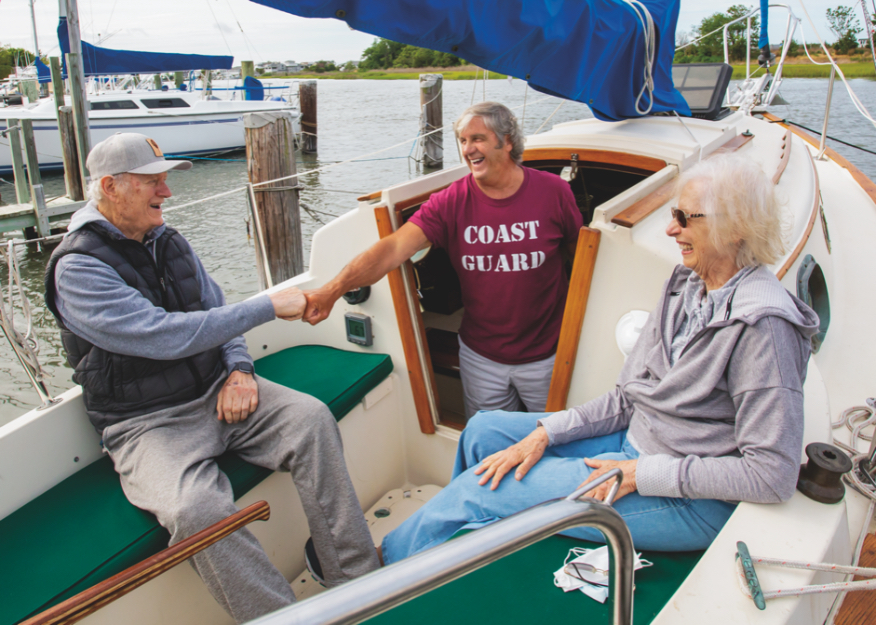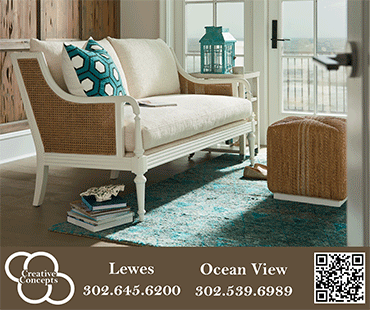
When your husband acquires a boat, be prepared to go along for the ride
By Jeanne Shook | Photographs by Carolyn Watson
From the August 2020 issue

“A guy walks into a bar …” and walks out with a boat. A not-so-funny punch line, but a true story.
In August 2019, over lunch and a few beers at a local pub, my husband, Dave, and his friend Tom Beall were discussing sailing. Dave, a Coast Guard veteran and former volunteer crew member on Delaware’s replica of the tall ship Kalmar Nyckel, had just competed in his first Cape-to-Cape race the day before, so sailing and boats dominated the conversation.
Long before the two friends discovered their mutual interest in sailing, however, they shared a common bond through tennis. Dave, a retired Lehigh University tennis coach, and Tom, an Atlantic Coast Conference tennis champion on the University of Maryland’s 1956 tennis team, met seven years ago on the clay courts at Rehoboth Beach Country Club.
For Tom, a Rehoboth-area resident who grew up in Bethesda, Md., sailing has been a lifelong sport, beginning in high school and continuing into adulthood. In 1983, he purchased a brand-new Flicka 20 sailboat at the Annapolis Boat Show. (Ironically, at the same boat show 12 years ago, I turned to my future husband and said, “I really don’t share your enthusiasm for boats.” He married me anyway.)
According to Tom, the boat was “one of the last of its kind manufactured in the United States.” This particular boat (hull No. 120) was built in 1980 and is one of only 400 Flickas produced by Pacific Seacraft Corp. Two years after purchasing it, Tom met his wife-to-be, Sarah, and soon Lyra, as the vessel was named, became “the love boat.” This cherished pocket cruiser — the term refers to boats larger than daysailers but light enough to be pulled by car trailer and launched from any boat ramp — became the couple’s “home away from home.” It served as their primary source of entertainment and enjoyment, provided Tom’s demanding work as a patent attorney for global giant Hitachi didn’t intervene.
But eventually, as Sarah puts it, “life hap-pened”: Work-related travel to Japan and health concerns took their toll, and the sailboat took a back seat. In 2005, the Bealls moved their
primary residence from Wye Mills, Md., to Rehoboth, closer to medical facilities and other resources, leaving the boat behind. But it was not long before Tom and Sarah brought Lyra to a slip in Lewes, though it ended up spending more time in dry dock at Anglers Marina than in the water. By 2013, when it became apparent that the vessel wouldn’t be entering the water anytime soon, Tom had it transported back to their Wye Mills home, where it remained in the driveway until 2019.
Fast-forward to last August. Unaware that Tom owned a sailboat, Dave was caught off guard when his friend offered it to him — for free.
“I have a boat. You want it?” were Tom’s exact words. Skeptical of the boat’s age and condition after being “on the hard” for so many years, my husband thanked his friend for his generous offer, and said he would think it over.
“Tom knew I loved sailing, and he was excited about the prospect of seeing it brought back to life,” recalls Dave. “I was reluctant at first, and if it was anyone else other than Tom, I probably would’ve passed on the offer.” Having just sold a motorboat a few weeks earlier, we were skeptical of acquiring another boat so quickly, “especially a vintage sailboat that hadn’t touched water in seven years,” says Dave.
But all that aside, the lingering question on our minds was: “What exactly is a Flicka?” An in-depth Google search ensued, and Dave discovered that the Flicka is to the sailboat what the original Ford Mustang was to the automobile: admired, coveted, enduring — and a cult classic. That’s when the tide turned, so to speak. He had to have it. “I always wanted a classic car to work on, and I ended up with a classic boat, which turned out to be even better,” says Dave.
The Flicka (which, in Swedish, translates to “happy little girl”) was the brainchild of naval architect and illustrator Bruce P. Bingham. Inspired by the simple lines and sturdy construction of 19th century workboats employed in the waters surrounding Newport and Block Island, R.I., Bingham’s goal was to design a small cruising yacht as rugged and seaworthy as those boats he so admired.
Bingham, out of the Navy and with his own naval architect business in 1972, saw his dream inch closer to reality when a series of his line drawings was published in Rudder magazine, a publication that featured small-boat designs and how-to guides for serious sailors and do-it-yourselfers. But construction materials and methods proved too expensive for amateur boatbuilders on a budget, so in 1975, Nor’Star Marine began producing “kits” for the mass boating market. The result was the Flicka 20, a 20-foot pocket cruiser (24-foot counting the bowsprit) suitable for day sailing, weekend cruises — or, for the ultimate adventurer, even sailing around the world.
In 1977, Pacific Seacraft took over the production, taking the boat’s quality construction and detailing to the next level. Upgrades included a hand-laminated fiberglass hull, teak trim, bronze fittings and an inboard engine. With just 400 of these vessels in existence around the world, the Flicka’s reputation as a classic boat was firmly established.
In testimony to its design and durability, many of these blue-water cruisers continue to circumnavigate the globe. With headroom not typically found on a boat this size — along with comfortable living quarters that feature a V-berth forward, a quarter-berth aft, a foldaway dining table, stainless steel sink, two-burner propane stove and ice box — the Flicka 20 is like an RV on water.
Given its compact size and ability to travel oceans, we began referring to our new vessel as “the little boat that could,” until officially changing its name to Second Wind just prior to its first sail. (Both widowed, Dave and I married in 2010 and retired to Lewes in 2012 to start a new chapter in our lives, hence the new name.)
Last September, when Dave took ownership of the 40-year-old boat, Lyra experienced “deja vu all over again” as it was transported back to Anglers Marina. With the Flicka now in our care, the Bealls were frequent visitors to the boatyard, keeping a watchful eye on it. The boat “has a history with us,” says Sarah, which was “one of the reasons Tom turned down offers to sell it. … It was difficult for him to part with it.”
As the work progressed, they were both delighted, and amazed, with the boat’s transformation. “It’s nice to have the boat go to someone who really cares for it,” notes Tom. That was an understatement, since what unfolded was a labor of love — an eight-month project that, by Dave’s estimate, has involved more than 500 hours of work, and counting.
Starting with the removal of several wasp nests (some of them still active), seven years of mold and mildew and four inches of standing water inside the cabin, he then began a tedious restoration of the boat’s teak trim, bronze hardware and customized brass features. The hull also received major TLC with a fresh coat of paint, buffed and polished to a bright shine.
Endless days of sanding, scouring and scraping resulted in tennis elbow, something my husband never experienced in his 40 years competing on the court. But ensuring that the Flicka was shipshape required that it be more than “just a pretty face” on dry land.
The “facelift” almost complete, Dave turned his attention to rebuilding the deteriorated rudder. He then hired Scott Gaston of Rehoboth Beach to replace the entire electrical and electronics systems. But his most monumental task was yet to come: refurbishing the engine. After replacing all the fuel lines, emptying and cleaning out the diesel fuel tank and replacing the contaminated fuel filters, he was rewarded as the boat’s engine finally roared to life (or more of a putt-putt, depending upon which one of us is telling the story).
On May 25, 2020, after being in dry dock for eight months, our “happy little girl” was ready to test the waters. Assisted by friends and veteran sailors Nick Carter and Xavier Wauters, Dave eased the boat into the Lewes-and-Rehoboth Canal, guiding it the half-mile to a slip on Pilottown Road. There to witness the launch and energized by the sight of their Flicka afloat once more, the Bealls were giddy with excitement and anticipation. Unable to contain his emotions, Tom said, “I feel like a kid again. … I love it!” Echoing her husband’s sentiments, Sarah marveled, “When you say ‘Second Wind,’ it’s kind of like a rebirth. … We’re so excited!”
A few weeks later, at Dave’s invitation, the Bealls boarded their old vessel for its maiden voyage. “My plan from the beginning was to have Tom and Sarah as my first passengers,” Dave notes. “… It was my gift to them, and a fitting way to thank them for their generosity, but most of all, to honor our friendship.”
And though I don’t share my husband’s enthusiasm for boats, I must admit that this one is special. As Flicka creator Bingham observed, “A yacht, however large or small … old or new, tells who and what we are: caring owners and loving friends. She is the profound expression and extension of ourselves. You’ll know her when you see her.”



